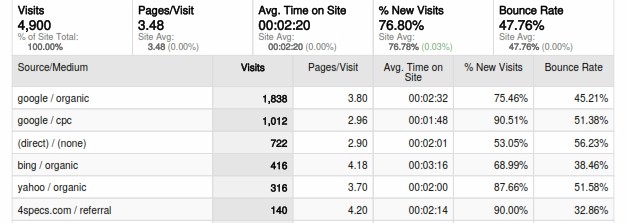
August 2014 Newsletter
**** The 4specs Perspective
I received an email from an advertiser with several great questions, and I thought my response would be useful for you.
The Email is shown in bold and indented below:
I am working on a project for my manager and we are breaking down each paid service we use to show the value and I was hoping you could give me an explanation for a few things.
1. What exactly qualifies as a referral from 4Specs?
2. Where are referrals generated?
A referral is recorded when a 4specs visitor goes to a section page your company is listed on, sees your showcase listing or free link and clicks on the link to be sent to your website. 4specs is coded to send the referrer (where the visitor came from) to your website server's logs and to Google Analytics. I use an onmousedown javascript event to track the click - this means that robots do not trigger the counter.
You can track the incoming referrals in your Google Analytics or other web analysis program. At the end of the month I eliminate daily duplicates based on the date and IP# and manufacturer's url.
3. How does a referral help us?
Let's start by defining the goal of your marketing and sales efforts. Your goal is most likely to profitably sell products.
As a first step in selling a product, you need to be specified during the design phase or be accepted as an alternative or substitution during the bidding or construction phase.
Historically local reps and trade shows along with 3-ring binders and Sweets catalogues were used to provide the design and specification information.
Today most product research is done online. We see architects using key words and Google to find the product information and full-time specifiers frequently use 4specs to find the CSI section and listed manufacturers.
When evaluating different publications (I include websites as publications) separate the offering into several different categories:
1. Cost per user and number of users brought to your data by the publication.
2. Cost of hosting your data - when the resource hosts your website.
3. Cost of developing downloaded information such as 3-part specs, CAD, BIM and LEED statements. What is the annual cost of hosting that data compared to paying to develop the information using consultants and hosting on your own website.
Use a spreadsheet to track how users come to your website and their performance. Key performance indicators are found in your Google Analytics. Here is an example of one manufacturer's Traffic Sources Report.

Summarize the data in a spreadsheet by month or by publication

Several years ago 4specs did a survey of advertiser's Traffic Sources from their Google Analytics Survey https://www.4specs.com/mediakit/analytics_exec_summary.pdf
Where your website links to the resource and sends your users there, use Google Analytics to track out bound people sent to advertising sites and subtract from the number reported by the publication. This is easy to implement by adding some code to your outbound link. Here is an example of the code - your web designer can fine tune the code - or ask me for more information - the key part is in bold:
<a href="http://publication.example.com/XXXXX.html" target="_blank" onmousedown="_gaq.push(['_trackPageview', '/example']);">Visit Our Specs Here</a>
[Note there are 2 versions of Google Analytics and this is the new version]
A few websites do not send a referrer to your webserver, generally because they use a javascript open window command. In these cases add a query to your link so you can track the incoming referrals. This would be in the form of
http://www.example.com/?problempublication
Feedback and questions are always appreciated.
Colin
--------------------------------------
Colin Gilboy
Publisher - 4specs
Contact us